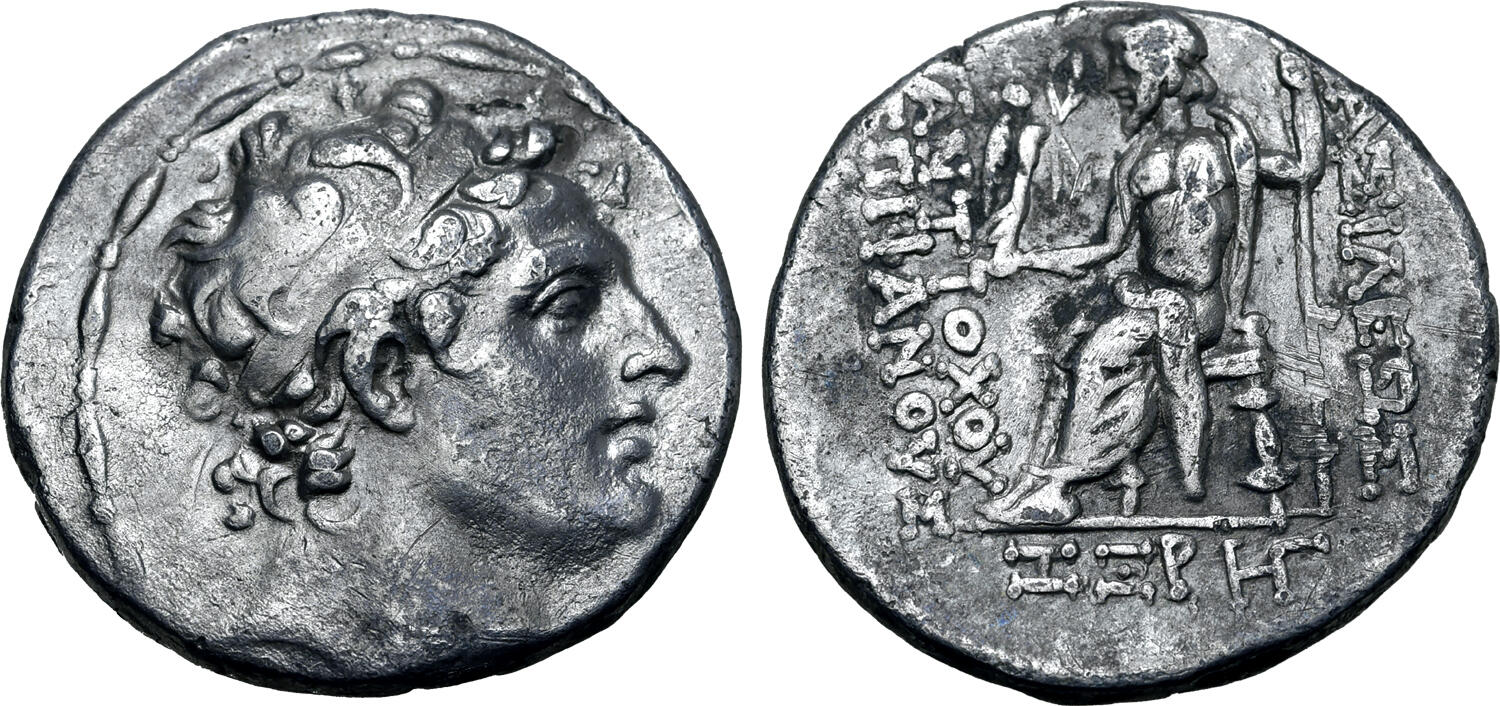Antioch (Antiochus IV), silver, tetradrachms (146-145 BCE)
From SILVER
146 BCE - 145 BCE Silver 1,203 kg
Description
| ObverseInscription or printing placed on the obverse.: | Diademed head to right. |
| ReverseInscription or printing placed on the reverse.: | ΒΑΣΙΛΕΩΣ ANTIOXOY ΕΠΙΦΑΝΟΥΣ (Greek).Zeus Nikephoros seated to left, holding sceptre, [B]AΣIΛEΩΣ to right, ANTIOXOY EΠIΦANOYΣ to left, IΞP and monogram in exergue. |
Mint and issuing power
| MintIdentifies the place of manufacture or issue of a numismatic object.: | Antioch | Ancient regionAncient region.: | Syria (Seleucis and Pieria) | Modern countryModern country: Turkey | AuthorityIdentifies the issuing power. The authority can be "pretended" when the name or the portrait of X is on the coin but he/she was not the issuing power. It can also be "uncertain" when there is no mention of X on the coin but he/she was the issuing power according to the historical sources: | Antiochus IV Epiphanes (Seleucid king, 175-164 BC), Seleucid Dynasty (312-63 BC) |
Chronology
| FromIdentifies the initial date in a range assigned in a numismatic context. | 146 BCE | toIdentifies the final date in a range assigned in a numismatic context.. | 145 BCE | PeriodTime period of the numismatic object.: Hellenistic 323-30 BC |
Physical description
| MetalThe physical material (usually metal) from which an object is made.: | Silver |
Median weightMedian of the weights of numismatic objects (in grams). in grams | 16.80 | DenominationTerm indicating the value of a numismatic object. Examples: tetradrachm, chalkous, denarius.: | tetradrachm |
StandardStandard.: | Attic |
Image

H291 Antiochos IV posthumous tetradrachm.jpeg [1]
References
| Die study referencePublication of the study: | Mørkholm 19601Mørkholm 1960, p. 25-30, pl. 1. | ||
| Coin series referenceReference to coin series study: | RQEMH2RQEMH, n° 291, HGC 93HGC 9, n° 744, SC II4SC II, n° 1885 | ||
Obverse dies distribution
| FrequencyFrequency of specimen in distribution. ᵖ | Number of obversesNumber of obverse dies. ᵖ (o) | % (o) | Number of coinsNumber of coins. (n) | % (n) | Die nameName(s) of the die(s). |
| 1 | 1 | 33.33 | 1 | 9.09 | 2 |
| 2 | 1 | 33.33 | 2 | 18.18 | 3 |
| 8 | 1 | 33.33 | 8 | 72.73 | 1 |
| Total | 3 of 3 | 99.99 | 11 of 11 | 100 |
Reverse dies distribution
no distribution is available
Quantification
| Number of obversesNumber of obverse dies. ᵖ (o) | 3 | Number of singletons (o1)The number of singleton coins. ᵖ | 1 |
| Number of reverse diesNumber of reverse dies. (r) | 9 | Number of coinsNumber of coins. (n) | 11 |
| Coins per obverse dieNumber of coins per obverse die. (n/o) | 3.67 | Coins per reverse dieNumber of coins per reverse die. (n/r) | 1.22 |
| Reverse per obverse ratioRatio of obverse dies divided by reverse dies. (r/o) | 3 | Percentage of singletons (o1)number of coins (n) divided by the number of singletons (o1) ᵖ | 33.33 % |
| Original number of dies (O) (Carter 1983 formula)The estimation of the number of coins according to Carter 1983 ᵖ | 3.58 | Coins struck if 20,000 as average productivity per dieCoins made if the average productivity for obverses (according to Carter) is 20,000. ᵖ | 71,600 |
| Original number of dies (O) (Esty 2011 formula)The estimation of the number of coins according to the singleton formula in Esty 2011 ᵖ (O) | 4.13 | Survival rate if 20,000 as average productivity per dieSurvival rate if average productivity is 20,000. ᵖ | 0.00015 |
| Coverage (o = % of O) (Esty 1984 formula)Esty 1984 - coverage (% of O) ᵖ (o = % of O) | 90.91% | Die productivity if survival rate 1/2,000Average productivity if survival rate is 1/2,000. ᵖ | 6,145.25 |
| Weight of silver (in kg) if 20,000 coins per die (O = Carter formula)Carter 1983 * Median weight * 20000 (*10 if gold or electrum) ᵖ | 1,203 kg <br /> 1,203 kg | Die productivity if survival rate 1/5,000Average productivity if survival rate is 1/5,000. ᵖ | 15,363.13 |
Remarks
Most likely one single workstation
References
- ^ Morkholm, Otto (1960), "A Posthumous Issue of Antiochos IV of Syria", The Numismatic Chronicle 6/20, p. 25-30, pl. 1.
- ^ Callataÿ, François de (1997), Recueil quantitatif des émissions monétaires hellénistiques, Numismatique Romaine, Wetteren, X + 341 p.
- ^ Hoover, Oliver D. (2009), Handbook of ancient Syrian coins : royal and civic issues, fourth to first centuries BC, The Handbook of Greek Coinage 9, Lancaster, lxix, 332 p.
- ^ Houghton, Arthur - Lorber, Catharine C. - Hoover, Oliver D. (2008), Seleucid coins : a comprehensive catalogue. Part 2, Seleucus IV through Antiochus XIII, 2 v., New York - Lancaster - London, (xxx), 120 p. of plates : ill., maps, tables